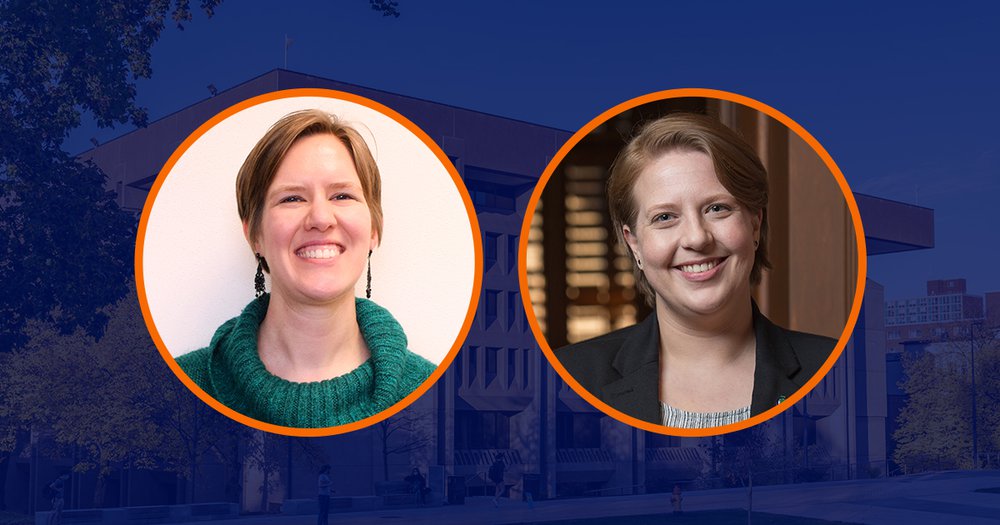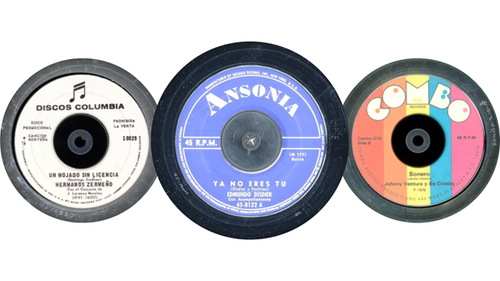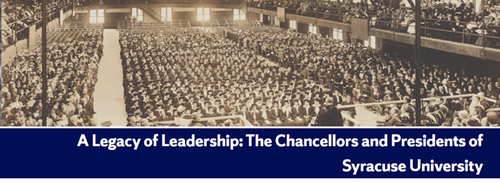The Digital Underground: Interdepartmental Collaboration

by Brittany Bertazon, Graduate Assistant for Digital Library Program
Interdepartmental Collaboration and the Power of Partnerships
At first glance, it might seem like the Libraries’ music cataloger, Chelsea Hoover (pictured left) and the Assistant University Archivist and Pan Am 103 Archivist, Vanessa St.Oegger-Menn (pictured right) hold very different positions at Syracuse University Libraries. Chelsea is a catalog librarian who works in the Acquisitions and Cataloging Department in the basement of Bird Library. Vanessa is an archivist who works on the top floor of Bird Library in the Special Collections Research Center (SCRC). At Syracuse University Libraries, catalogers like Chelsea generally work behind the scenes to record information about the Libraries’ holdings that help researchers find and use them, while an archivist like Vanessa might have a wider variety of duties, working to arrange and describe collections of unique materials and interacting with donors and researchers. As a music cataloger, Chelsea works almost exclusively with commercial, recorded sound collections. Vanessa, on the other hand, spends most of her time working with the Pan Am 103 collections and helping manage the university’s archival records.
Because the Digital Underground series looks at the contributions that staff across the Libraries have made to the Digital Library Program (DLP), we are presenting these separate interviews together, Chelsea and Vanessa discuss their daily responsibilities and how both their roles contribute to overarching DLP projects and initiatives, highlighting just how much the DLP’s success relies on affiliated departments and staff throughout the Libraries.
Brittany: Tell me about your role at the Libraries.
Chelsea: As the Catalog Librarian for Music, I work specifically with music-related materials and collections, music scores and historic sound recordings housed in Syracuse University’s Belfer Audio Laboratory and Archive. In cataloging these materials, I am responsible for preparing bibliographic records to represent items acquired by the Libraries that will provide efficient access and retrieval for users.
Vanessa: I am the Pan Am 103 Archivist and Assistant University Archivist within the Special Collections Research Center. My primary responsibilities are overseeing all functions of the Pan Am 103 Archives, which include donor relations, collections processing, reference, instruction, physical and digital exhibitions, you name it.
I also support many of those same functions for the University Archives under University Archivist Meg Mason.
Brittany: What is your background and how did you get to where you are now?
Chelsea: My undergraduate degree and my first master’s degree are both in music performance, specifically horn performance, from the University of Georgia. Afterwards, I received my second master’s degree in library science with a specialization in music librarianship from Indiana University Bloomington.
I was previously the Music and Media Cataloging Assistant at the University of Arkansas before coming to Syracuse University, where I started my position in February of 2020.
Vanessa: I have a master’s degree in 20th century British literature from California State University, Long Beach, and I received my master’s degree in library and information science from Syracuse University. When I was a graduate student in the library and information science program, I worked as a Reference Assistant in the Special Collections Reading Room staffing the desk and answering reference questions.
Directly after finishing my MSLIS degree at SU, I worked in Access and Resource Sharing for a year, primarily on the circulation desk and with course reserves. I joined SCRC as a full-time archivist in 2015. I always kind of joke that I just hung around until they hired me.
Brittany: How does your distinctive role at the Libraries intersect with the Digital Library Program?
Chelsea: As you know, the DLP showcases materials within Syracuse University Libraries, particularly from the Special Collections Research Center, in their digital collections. Because my duties as a music cataloger largely involve cataloging historic sound recordings from SCRC’s Belfer Audio Laboratory, the DLP has created digital collections featuring Belfer sound recordings I have cataloged, such as the Latin American 45 Records Digital Collection. When creating these digital collections, the DLP personnel use the metadata from the catalog records of these sound recordings to help make user searches within these digital collections as discoverable as possible. Therefore, when I create these catalog records, I try to include as much information as possible to be most helpful to users.
Vanessa: When the University Archives and Special Collections were separate departments, all of our digital work was also separate, aside from consulting with Sarah [Pohley] and Suzanne [Preate] in the Digital Production Unit on some digitization. We actually did quite a bit of our own [digital production work] in-house with our own equipment. When I first came into my position, I was working with Meg to coordinate metadata creation which was overseen by the two of us but really implemented by our graduate students; they were the ones physically entering the data.
My involvement with the DLP grew increasingly over the years, primarily working with cleanup of legacy metadata. When the departments merged, there was more of a desire to have representation from the Archives in the overall DLP as it was developing. Meg assumed a position as part of the core team for the DLP, and I was approached by [DLP Program Head] Déirdre [Joyce] to become a member of the metadata advisory group.
Brittany: What kind of equipment or technology do you use most frequently?
Chelsea: OCLC Connexion, a full-service cataloging tool used to create and edit high-quality bibliographic and authority records, is the prominent software for my job. In OCLC, I also use a lot of macros (macros are short programs you write to automate routine tasks that are built from commands) for descriptive metadata fields. These macros make cataloging much more efficient because I can just run the macros, and the fields on which I am applying the macros will automatically appear without me having to manually enter anything. I also use Voyager, an integrated library system, which serves as the database for SU libraries.
Vanessa [describing involvement in digital projects]: We are not doing as much of our own digitization as we did in years past, but we do still have some equipment for really urgent requests, but it’s incredibly rare. The metadata cleanup work that we’re doing is actually being done in Microsoft Excel. We’ve reached a point now where bulk changes are no longer possible so we’re literally going through manually and cleaning up individual records in preparation for a future merger of the Archives’ legacy metadata with records from the department as a whole.
Brittany: How has working from home due to Covid been for you?
Chelsea: As you know I had just started my position at SU Libraries in February of 2020 and was only on campus for one month before the lockdown began and we were all sent home to work remotely. And of course, none of us saw this coming or anticipated that we’d be in lockdown for multiple months. In some ways it’s been kind of nice steadying my schedule from home, but in some ways I’m also ready to get back to campus . Aside from being ready for more in-person interactions with co-workers, I miss my standing desk and having multiple desktop monitors to be able to do certain tasks more efficiently. Like many others, my work and home-life balance has also been somewhat blurred.
Fortunately, since I have image and audio files on a flash drive of the sound recordings in the sound recording cataloging project I am working on right now (the Latin American 45s Collection), I have a lot to keep me busy while we’re remote. But for future cataloging projects, specifically with Belfer sound recordings that have not been digitized, I’ll definitely need to be back on campus to complete those.
Vanessa: In terms of digital projects, we actually were able to hack out a lot of legacy metadata cleanup during the initial months of the lockdown. This has been a multi-year project that was on the back burner a bit for a couple of years. The work-from-home period meant we weren’t able to continue many of the projects we normally work on in the archives – like processing or curating exhibitions – so we were able to make quite a dent in the digital realm, particularly with both of our graduate students also working remotely during that time. More generally, working from home due to Covid was initially a bit of a shock as someone whose work is so closely tied to accessing physical collections on a daily basis. There were moments of frustration, missing the collections, and missing the routines of being on campus each day. But we were also able to try some new and exciting things, like a foray into digital collecting for the University Archives’ Documenting the Syracuse University Experience of the COVID-19 Pandemic project.

Three images of different record labels, from the Bell Brothers Collection of Latin American and Caribbean Recordings, all of which are in Spanish, and part of Syracuse University Libraries’ Special Collections Research Center’s Latin American 45s Digital Collection.
Brittany: Are you currently working on any projects for the DLP or have anything on the agenda for the future?
Chelsea: A big project I’m working on right now in part for the DLP is the Latin American 45s Digital Collection, which encompasses over 12,000 recordings held in the Belfer Audio Laboratory and Archive. A majority of the collection comes from the Bell Brothers Collection of Latin American and Caribbean Recordings. Max and Joseph Bell were the owners of a New York City record store, the Bell Music Box, from which Syracuse University acquired the entire inventory of 45-rpm discs in 1963. While images of all record labels and covers in the collection as well as basic metadata about each recording are publicly available and searchable online, new audio files are added on an ongoing basis as recordings continue to be digitized. I do original cataloging for the audio materials and am currently working on cataloging the thousands of records from the collection.
As far as future projects with the DLP are concerned, I will be working on migrating the catalog records from the Belfer cylinders recordings to the new digital asset management platform, Quartex. Specifically, I will be helping advise the DLP team on what metadata fields would be most helpful to users in Quartex and update subject headings from these records as necessary.
Vanessa: I recently curated a small exhibition as part of the Archives’ programming for the University’s sesquicentennial about our twelve chancellors titled “A Legacy of Leadership: The Chancellors and Presidents of Syracuse University”. We were fortunate to get the physical version installed before the lockdown, but just barely. Luckily, we were able to create a digital version of the exhibition so that it could still be accessed while everyone was away from campus. This was among some of the first digital exhibitions we’ve produced using the Libraries’ new template, so it was nice to have the opportunity to work with members of the DLP through that process. I’m looking forward to exploring the digital exhibitions space more in the future, including for an upcoming digital exhibition I’m curating about the 1970 Student Strike.

“A Legacy of Leadership: The Chancellors and Presidents of Syracuse University” exhibition, curated by Vanessa St.Oegger-Menn, uses documents and photographs from the University Archives to “examine the ways in which each of the individuals who have held the University’s highest office have shaped the institution from its humble beginnings to the modern, student-focused, research university committed to academic excellence and inclusion it is today.” This online exhibition was in part made possible by the Digital Library Program, Libraries Information Technology Services (LITS), Libraries Marketing and Communications department, as well as other Special Collections Research Center (SCRC) staff.
Brittany: What is one thing no one ever knows about what you do?
Chelsea: I would say people don’t typically realize the amount of time and attention to detail that really goes into cataloging materials. For example, how having the proper access points for performers or composers associated with the records can make a difference in how accessible the records are to users.
Vanessa: I think people don’t realize the variety of work in archival positions. There is often a belief that archivists have lists of certain types of information just laying around or that everything is digitized. I think patrons often don’t realize that we are doing a variety of types of work– digital library work, exhibitions work, donor relations work, processing collections– and that all of those things can sometimes happen in the same day, from hour to hour.
I think part of the issue is that the archivists have not always been great about sharing with people what we do, or the time and considerations involved in archival work. Yes, it might be relatively quick to just scan something but then there is also the metadata work to describe the item, the preservation work to maintain it, and the privacy and digital rights work before we can make something available.
Brittany: What makes you feel most fulfilled in your role?
Chelsea: For me being a cataloger feels like getting paid to solve puzzles, specifically when you have to do detective work to determine what the correct access point is for a performer or composer or what subject headings would best fit in a catalog record. And I really enjoy doing puzzles, so having a job as a cataloger is a huge win. A bonus for my particular role is that I specifically catalog music materials, and as I mentioned earlier, my background is in music performance, so this position puts my music training to use even though I’m not performing.
Vanessa: I think it depends on what kind of work I’m doing at the time but the initial reason I became an archivist is because I love the research element of it, and I love the processing element. Whether it is doing reference work or exhibitions curation, that moment where you find just the perfect thing and it connects so many of the other disparate points, you do kind of have something like an Indiana Jones moment. You’ve found an item or a document that can help tell the story better, or it can help illuminate a particular moment in history that maybe hasn’t been focused on or isn’t the dominant narrative that we’ve all known for however many years and shows people something in a different light.
